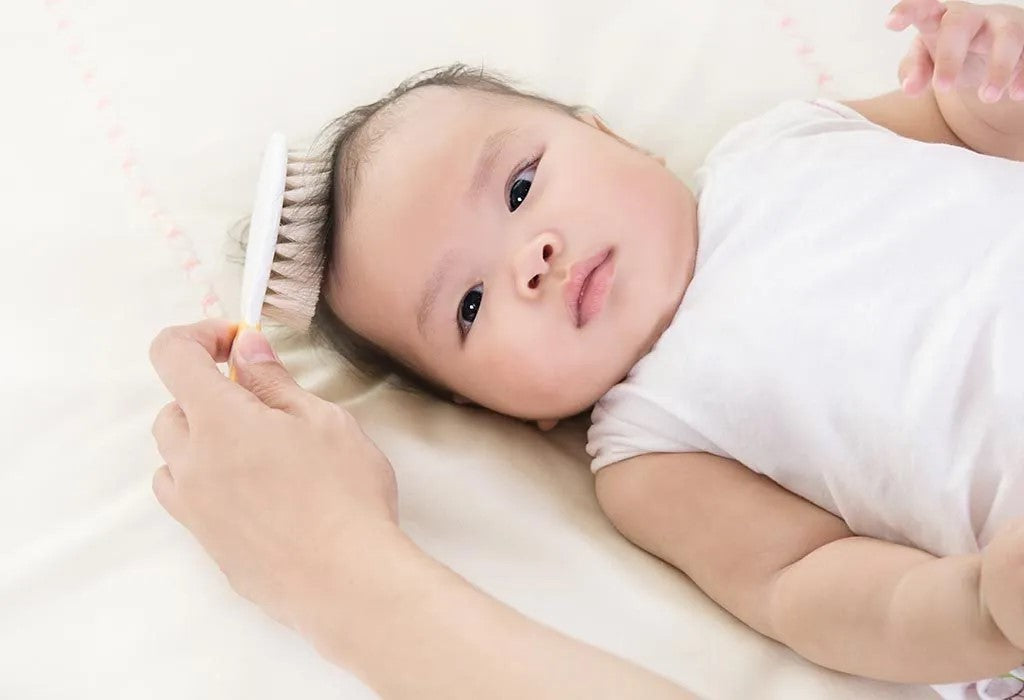Let's talk about one of those little quirks of babyhood that can sometimes leave us scratching our heads (and our baby's scalp) - cradle cap.
If you've noticed those flaky, crusty patches on your little one's head, don't worry - no need to run to the ER! Cradle cap is a common and harmless condition that affects many babies.

So, what exactly is cradle cap?
Well, it's basically a fancy term for a form of infantile seborrheic dermatitis - a harmless, temporary condition that causes scaly, yellow-tinged patches on a baby's scalp (and in some cases, eyebrows). And while it may not be harmful, it can certainly be unsightly and a bit of a cosmetic nuisance.
Did I do something wrong?
No. No. No. It has nothing to do with your care.
Researchers likely attribute the development of cradle cap to glands in your baby’s scalp that produce excess oil. This causes the skin cells that normally shed from your baby’s scalp to remain stuck. Hence those flaky, greasy patches.
It’s 2024 and it can be annoying not to know for certain why the cradle cap develops but what is certain is that you did nothing wrong, and it’s not your fault. Phew!
So, what can I do about it?
Although cradle cap isn’t dangerous, doesn’t cause discomfort, and will likely clear up on its own, you don’t want your future teen to have complaints about their bad-hair-day baby pics…..
So, follow this gentle care regimen to banish those pesky flakes and restore your baby's scalp to its soft & smooth glory.

1. Soften the skin.
Before you wash your baby’s hair, gently apply an emollient to their scalp and work it in with a gentle massage. This will soften their skin. With an fragrance-free, leave-in formula, Mustela Cradle Cap Cream is a great place to start. (Obvs.)
Baby skin is delicate, so avoid any complex oils or chemical-laden products intended for adults. You’ll want to use a simple and natural moisturizer designed specifically for babies such as the Mustela emollient cream.

2. Gentle cleansing
Fill the baby bath tub with warm water, and start by gently lathering your baby's scalp with a mild baby shampoo. We love the fridababy shampoo and body wash for its skin-soothing and tear-free qualities.
Use your fingertips (not your nails) or a soft baby brush to loosen and lift the scales, being careful not to scrub too hard or irritate the skin.
Or, try the whole process with this innovative 3 in 1 Fridababy flake fixer that was specially designed to remove cradle cap.You simply lather in the shampoo with the soft foam sponge, loosen the scales with the bristle brush, and then lift the flakes out as you brush your baby’s hair with the fine tooth comb.

3. Post-bath brushing
After bath time, gently brush your baby's scalp with a soft baby brush to help loosen any remaining flakes and improve circulation. This can also help prevent cradle cap from coming back in the future.
Even if you uncover some stubborn patches, never pick at those scales. It may be tempting to just pry them loose, but that can actually create areas of raw skin which is breeding ground for infection.

4. Natural magic
Many moms swear by the power of coconut oil for treating cradle cap. Simply massage a small amount of organic, virgin coconut oil or some dry-skin cream onto your baby's scalp, let it sit for a few minutes to soften the scales, then gently comb through and rinse with warm water during bath time.
Once we’re on the topic of food remedies, if your baby's cradle cap seems particularly stubborn or uncomfortable, consider giving them an oatmeal bath spa day!
It’s easy. Blend some plain oatmeal into a fine powder, sprinkle it into a baby bath tub filled with warm water, and let your little one soak for 10-15 minutes. The soothing properties of oatmeal can help calm irritated skin and alleviate itchiness.
5. Avoid overwashing
While it may be tempting to wash your baby's hair more frequently to combat cradle cap, overwashing can actually exacerbate the problem by stripping the scalp of its natural oils, leading to dryness, and worsening the cradle cap.
Stick to gentle cleansing just a few times a week, and be sure to rinse thoroughly to remove any residue.
When does it need medical attention?
If your baby's cradle cap doesn't seem to improve with home care, or if you notice any signs of infection or irritation, reach out to your pediatrician for guidance. They can recommend additional treatments or refer you to a dermatologist if necessary.

Put a cap on worrying about cradle cap
Cradle cap is very common and completely harmless, though your anxiety over seeing the rash and scales is normal. It is not because of anything you did (or didn’t do), and you can rest assured that your baby is absolutely, 100% perfect, whatever his scalp looks like.


